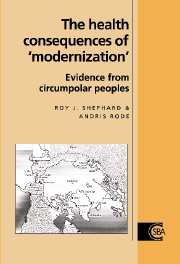Book contents
- Frontmatter
- Contents
- Preface
- 1 The circumpolar habitat and its peoples: traditional lifestyle and early research findings
- 2 Concept of the International Biological Programme Human Adaptability Project, and IBP studies of circumpolar populations
- 3 Changes in social structure and behaviour
- 4 Secular trends in diet, metabolism and body composition
- 5 Secular trends in physical fitness and cold tolerance
- 6 Secular trends in respiratory hazards, lung function and respiratory disease
- 7 Secular trends in growth and development
- 8 Current health status of circumpolar populations
- 9 Postscript: lessons from traditional circumpolar life and options for the future
- References
- Index
2 - Concept of the International Biological Programme Human Adaptability Project, and IBP studies of circumpolar populations
Published online by Cambridge University Press: 05 March 2012
- Frontmatter
- Contents
- Preface
- 1 The circumpolar habitat and its peoples: traditional lifestyle and early research findings
- 2 Concept of the International Biological Programme Human Adaptability Project, and IBP studies of circumpolar populations
- 3 Changes in social structure and behaviour
- 4 Secular trends in diet, metabolism and body composition
- 5 Secular trends in physical fitness and cold tolerance
- 6 Secular trends in respiratory hazards, lung function and respiratory disease
- 7 Secular trends in growth and development
- 8 Current health status of circumpolar populations
- 9 Postscript: lessons from traditional circumpolar life and options for the future
- References
- Index
Summary
This chapter examines the concepts underlying the Human Adaptability Project of the International Biological Programme (IBP-HAP), with particular reference to its studies of circumpolar populations. Critical issues for the project were an appropriate sampling of the populations of interest, an inter-laboratory standardization of methodology, and the adoption of common units for the reporting of data. Comment is offered regarding the study's reliance on cross-sectional rather than longitudinal data, and the underlying concept of human adaptability is evaluated critically.
Human Adaptability Project
The concept of biological adaptability extends back to Charles Darwin (1859). Studies conducted during the voyage of the ‘Beagle’ convinced Darwin that the unusual inherited characteristics of certain species gave them a competitive advantage in colonizing a particular habitat – there was a ‘survival of the fittest’.
The IBP-HAP, which originated in the early 1960s (Harrison, 1979; Weiner, 1964; Worthington, 1978), adopted a Darwinian perspective. It argued that small inherited differences of body build and biological characteristics had emerged between various ethnic groups over many centuries of separation from each other, and that such differences had given certain populations a survival advantage when exploiting a specific habitat. One basic objective of the IBP-HAP was thus to trace the potential extent of human adaptation to adverse environments, determining how far differences in biological characteristics had influenced the observed patterns of colonization. It was further hypothesized that humans as a whole had made an evolutionary adaptation to the lifestyle of hunter–gatherer or subsistence farmer over many centuries, and that levels of both fitness and health would be much lower in populations which had abandoned the traditional way of living.
- Type
- Chapter
- Information
- The Health Consequences of 'Modernisation'Evidence from Circumpolar Peoples, pp. 43 - 57Publisher: Cambridge University PressPrint publication year: 1996



